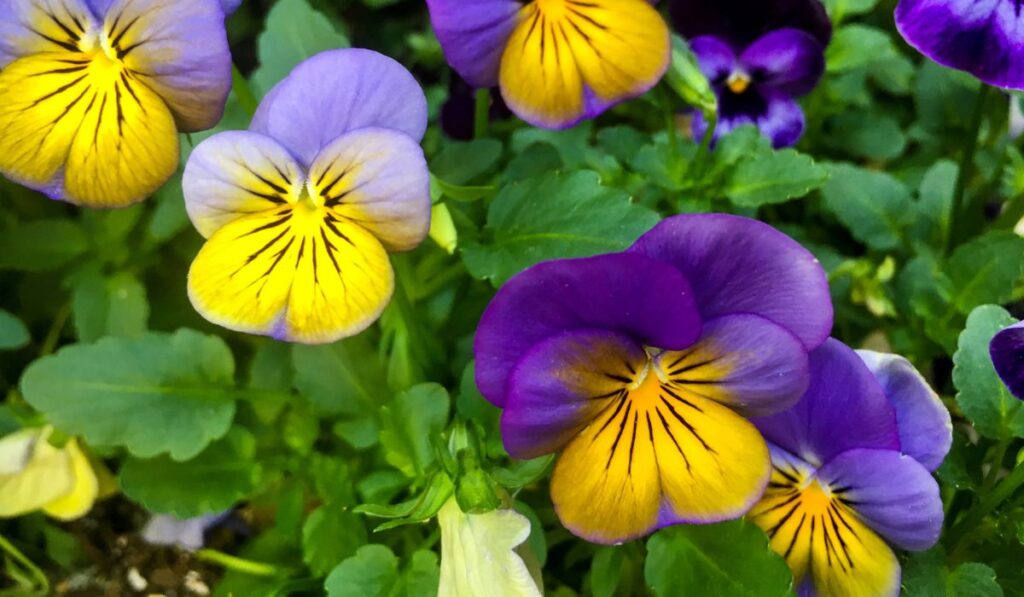Johnny jump ups are beautiful plants with their heart-shaped leaves and pretty petals. They are easy to maintain and much easier to grow in containers, borders, or beds, thanks to their adaptability. The best part is that they are also edible, so you’ll be in for an excellent treat.
If you want to grow Johnny Jump Up seeds, consider sowing them from early spring through fall. You should cultivate them in rich soil with good drainage. Make sure they get lots of sun, moderate shade, and plenty of water to keep them strong, healthy, and colorful.
If you’re looking to grow Johnny Jump Up seeds, this post will highlight everything you need to know, including how to plant them and how long they’ll take to germinate. We’ll also cover whether they can survive frost.
When Can You Start Johnny Jump Ups?

Johnny jump ups (on Amazon) do well in cool to warm climates, so you should shade them in hot climates. You can cultivate their seeds during early spring, but if you decide to plant them indoors, you should begin planting around 6 to 8 weeks before the last frost.
Before starting Johnny Jump Ups, consider the following factors:
Temperature
Johnny jump ups are sensitive to hot temperatures but enjoy mild and cool weather. They usually wilt under extreme heat, so maintain the humidity level at low to moderate because excessive moisture can also cause fungus and mildew.
Fertilizers
Violas will significantly benefit from a gradual, well-balanced fertilizer during spring and fall. These nutrients will support their continuous blooming. If you, however, live in a sunny location, your plants will be dormant because of the heat, so it’s advisable to avoid fertilizing them frequently.
Light
Similar to other flowering plants, violas thrive in direct sunlight. Therefore, you should place them in regions with at least six hours of direct sunlight each day. These plants may also do better in a shaded environment, especially in areas where the summer sun is scorching.
Soil
Johnny jump ups need moist, nutrient-rich soil that drains well. Before planting the seeds, enrich your soil with plenty of compost to improve the current soil conditions. Compost helps the ground drain extra water while adding essential nutrients.
Water
Constant watering is required to keep the moist soil conditions desired by johnny jump ups, especially in summer when wilting can occur from too much heat.
You should note that Violas are prone to mildew and fungus. Therefore, to avoid such issues, you should avoid getting the leaves wet when watering. Instead, ensure you water them close to the soil at the base of the plant.
How Do You Plant a Johnny Jump Up From Seed?
You can fully plant a Johnny jump-up seed directly into the flower garden or indoors for transplanting afterward. If you want them to bloom by spring, keep the seeds in pots and containers indoors 6 to 8 weeks before the last frost. Ensure you keep them under an eighth inch of warm and moisturized soil.
If you would like transplants instead, you can easily find them at most garden centers and nurseries. You should transplant them at the end of your area’s last frost date. If you go for a flower bed, develop a layout and color scheme or use mixed varieties before planting.
There are various ways you can sow the johnny jump-ups:
Direct Sowing
It would help if you looked for a conducive place outdoors where your flowers will receive 6 to 8 hrs of sunlight daily. If you live in a hot area, the plants will wither unless you keep them under shade.
To cultivate the seed directly into the soil, ensure the ground is enriched with the necessary nutrients and is well-drained with a pH of 5.4 to 5.8. But if you decide to sow them in containers, fill the tins with a potting mix.
Make several quarter-inch divots with your finger, spacing them at least six inches from each other and the nearby plants. Spacing them should not worry you if you have limited space. They will face minimal harm when they rub against each other.
In every hole, plant two seeds, then fill them with soil. Next, use a spray bottle or your hose’s misting setting to water the plants. Germination should then take place in at least 7 to 10 days.
Indoor Sowing
Six to eight weeks before your area’s last frost date is the optimal time to start Johnny-jump-up seeds indoors.
- First, make a 1/4-inch incision in the seed-starting trays before adding the seed-starting mix. Each hole should contain two seeds loosely covered in soil. Use a spray bottle for watering to prevent the seeds from spreading.
- Position the tray in a sunny spot, or you can use a heat mat. Cover it with plastic wrap or a humidity dome to trap moisture.
- The soil should remain moist until germination, 7 to 10 days later. Once the seeds start to sprout, take off the lid and place the tray somewhere with 6 to 8 hours of exposure, like a sunlit window.
- It’s ideal to start watering your plants at most once or twice weekly as long as the soil remains moist 2 inches deep. To determine this, check with a soil moisture meter, though you can also use your finger.
- Get rid of the smaller two seedlings within every cell once they develop two pairs of leaves to prevent the tougher ones from absorbing all the nutrients.
- When the ground thaws and the temperature is constantly around 40°F, you can start hardening them off.
They will be fit for transplanting after a week of staying outdoors.
Transplanting
Perhaps you got your Johnny-jump-up from a nursery but are clueless about what to do. We have you sorted.
- First, choose an area that receives a sun exposure of 6 to 8 hrs or 4 to 6 hrs (depending on your zone) with regular afternoon shade.
- Before sowing, dig a hole with a depth and width similar to the johnny jump up root ball.
- Add manure or 10-10-10 NPK fertilizer (on Amazon) according to the container’s instructions.
- Remove the root ball from its container, and dip it into the hole.
- Add soil back in and generously water it.
Within no time, you’ll be looking at the foliage and soon be admiring your flowers.
How to Maintain Johnny Jump Ups

Violas are usually covered in cheery blossoms throughout spring and early summer. Whenever the temperatures are not too hot, you can cut them to a few inches tall after they first flower for a second flush of bloom. In mild weather, Johnny jump ups usually self-sow and return each season.
Make sure you use mulch to reduce weeds in your flower garden. It will save you the time and energy of manually weeding the flowerbed or container. But you’ll have to inspect the area weekly to pull a few weeds and deadhead flowers surviving through the mulch. This will prolong the Viola’s blooming period.
How Long Does Johnny Jump Up Take to Germinate?
Johnny-jump-ups take around 14 to 21 days to grow, so you’ll have to be patient with them.
Can Johnny Jump Ups Survive Frost?
Johnny-jump-ups can withstand cold weather, including light frosts.
They can also survive the winter in temperate areas, but you should cover them whenever you expect snow or frost. The best way to safeguard them is by giving them sufficient mulch to insulate their roots.
You should, however, note that the potted plants may not thrive during winter because their soil is not insulated, unlike the ground soil.
